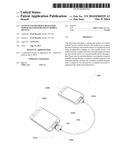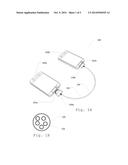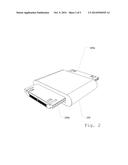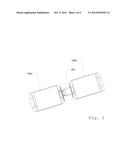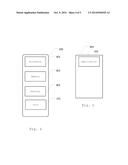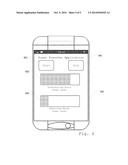Patent application title: System and Method for Battery Power Transfer Between Mobile Devices
Inventors:
Ford Meazell (Austin, TX, US)
IPC8 Class: AG06F126FI
USPC Class:
713300
Class name: Electrical computers and digital processing systems: support computer power control
Publication date: 2014-10-09
Patent application number: 20140304529
Abstract:
This disclosure describes a system and method for battery transfer
between mobile devices. The method can comprise the step of placing a
first mobile device in transferring mode using an application running on
a first mobile device. The method can also comprise the step of
transferring power from the first mobile device to a second mobile device
through a link. The system, in one embodiment, can comprise computer
readable storage having a computer readable program code embodied
therein, wherein the computer readable program code is adapted to be
executed by a computer processor to implement the method described above.Claims:
1. A method for transferring electrical power from a first mobile device
to a second mobile device, comprising placing a first mobile device in
transferring mode using an application running on said first mobile
device; and transferring power from said first mobile device to a second
mobile device through a link.
2. The method of claim 1 wherein said link is bidirectional.
3. The method of claim 2 comprising the additional step of providing a graphical user interface to a user of said first mobile device that allows a user to initiate the step of transferring power from said first mobile device to said second mobile device.
4. The method of claim 3 wherein said graphical user interface further allows said user to stop the step of transferring power.
5. The method of claim 3 wherein said graphical user interface displays a transferring phone power level.
6. The method of claim 3 wherein said graphical user interface displays a receiving phone power level.
7. The method of claim 1 wherein said link is unidirectional.
8. The method of claim 7 comprising the additional step of determining the direction of said link.
9. The method of claim 8 comprising the additional step of providing a graphical user interface to a user of said first mobile device.
10. The method of claim 3 wherein said graphical user interface displays a transferring phone power level.
11. The method of claim 3 wherein said graphical user interface displays a receiving phone power level.
12. The method of claim 1, wherein said first mobile device is a mobile phone.
13. The method of claim 9 wherein said second mobile device is a mobile phone.
14. A computer readable storage having a computer readable program code embodied therein, wherein the computer readable program code is adapted to be executed by a computer processor to implement the method of claim 1.
Description:
PRIORITY AND INCORPORATION BY REFERENCE
[0001] This application claims the benefit of and hereby incorporates by reference U.S. patent application Ser. No. 13/858,936 entitled "A Link for Battery Power Transfer Between Portable Electronic Devices," by Ford Meazell, filed on Apr. 8, 2013.
BACKGROUND
[0002] This disclosure relates to a system and method for battery power transfer between mobile devices. For purposes of this disclosure, a system and method for battery power transfer from one mobile device to another are discussed, and are an example of a system of method for transferring battery power from the battery source of one portable electronic device to another. However, such discussion of a system and method for battery power transfer between mobile devices is solely exemplary, and not limiting.
[0003] Methods for transferring battery power have evolved over the years. As battery technology evolved to create more powerful and compact batteries, portable devices proliferated. However, today's mobile devices are unable to transfer stored battery power for storage into another portable electronic device. Instead, portable electronic devices require charging a direct connection from a charger plugged into an electrical source. Such methods are inconvenient, as users can frequently find themselves away from an electrical outlet or other electrical source.
[0004] As such it would be useful to have an improved system and method for a system and method for battery power transfer between mobile devices.
SUMMARY
[0005] This disclosure describes a system and method for battery transfer between mobile devices. The method can comprise the step of placing a first mobile device in transferring mode using an application running on a first mobile device. The method can also comprise the step of transferring power from the first mobile device to a second mobile device through a link.
[0006] The system, in one embodiment, can comprise computer readable storage having a computer readable program code embodied therein, wherein the computer readable program code is adapted to be executed by a computer processor to implement the method described above.
BRIEF DESCRIPTION OF THE DRAWINGS
[0007] FIG. 1A illustrates two mobile devices connected by a link for battery power transfer.
[0008] FIG. 1B illustrates wires within a cord.
[0009] FIG. 2 illustrates a compact link.
[0010] FIG. 3 illustrates a transferring mobile device and a receiving mobile device connected by a compact link.
[0011] FIG. 4 illustrates hardware within a mobile device.
[0012] FIG. 5 illustrates memory within a mobile device.
[0013] FIG. 6 illustrates a mobile application running on a transferring mobile device.
DETAILED DESCRIPTION
[0014] Described herein is a system and method for battery power transfer between mobile devices. The following description is presented to enable any person skilled in the art to make and use the invention as claimed and is provided in the context of the particular examples discussed below, variations of which will be readily apparent to those skilled in the art. In the interest of clarity, not all features of an actual implementation are described in this specification. It will be appreciated that in the development of any such actual implementation (as in any development project), design decisions must be made to achieve the designers' specific goals (e.g., compliance with system- and business-related constraints), and that these goals will vary from one implementation to another. It will also be appreciated that such development effort might be complex and time-consuming, but would nevertheless be a routine undertaking for those of ordinary skill in the field of the appropriate art having the benefit of this disclosure. Accordingly, the claims appended hereto are not intended to be limited by the disclosed embodiments, but are to be accorded their widest scope consistent with the principles and features disclosed herein.
[0015] FIG. 1A illustrates two mobile devices 100 attached by connection/link for battery power transfer. Mobile devices 100 can include any communication or entertainment handheld device with the capability of operating independently of a direct plug-in to an electrical outlet. Specifically, mobile devices 100 can be portable and comprise a battery source internally that allows mobile device to receive power from external electrical sources. Mobile devices 100 can comprise, but are not limited to, cellular phones, MP3 players, CD players, or electronic tablets.
[0016] For access to battery power, mobile device 100 can have a port 101. In one embodiment port 101 can receive power and charge battery of mobile devices 100. In one embodiment, port 101 can transfer power out of mobile devices 100. In another embodiment, port 101 can both transmit and receive power. Whether used for input or output, port 101 can comprise any number or arrangement of connector pins, for example, and/or other electronic socket arrangements, which can be plugged into. For purposes of this disclosure, port 101 can be male or female.
[0017] In one embodiment, mobile devices 100 can each also have two separate ports 101, in which the first port 101 can receive input battery power, while the second port 101 can transmit output transfer power to another battery-operated device. In one embodiment, either first port 101 or second port 101 can have dual input-output transfer capabilities.
[0018] For the purposes of this disclosure, when one of mobile devices 100 transfers battery power to another battery, it can be referred to as a transferring mobile device 100a. Additionally, when mobile device 100 receives battery power from another device, it can be referred to as a receiving mobile device 100b. Transferring mobile device 100a can have a transferring port 101a. Transferring port 101a can be located on any surface of transferring mobile device 100a. Transferring port 101a can be accessible to link 103 for transfer of battery power. Receiving mobile device 100b can have a transferring port 101b. Receiving port 101b can be located on any surface of receiving mobile device 100b. Receiving port 101b can be accessible to link 103 for receiving battery power.
[0019] To facilitate transfer of power, mobile devices 100 can connect to link 103, which can connect mobile devices 100 together. In one embodiment, link 103 can comprise a cord with connectors 104 on each end capable of plugging into a port 101 on a surface of mobile devices 100. Link 103 can comprise a receiving connector 104a on one end, and a transferring connector 104b. Each connector 104, in one embodiment, can comprise one or more pins. Connector 104 is connectable to port 101, and can be female or male. Transferring port 101a can connect to receiving connector 104a, and transferring connector 104b can connect with receiving port 101b, in one embodiment by a cord. Connector 104 can include, but is not limited to, DC connectors, coaxial power connectors, mini USB connectors, micro USB connectors, or any iPhone connectors such as a 19 pin or 30-pin connector.
[0020] In one embodiment, link 103 can comprise a diode or other hardware which only allows for power to pass one direction between mobile devices 100 (unidirectional). In such embodiment, power transfer can occur from a transferring mobile device 100a to a receiving mobile device 100b. In another embodiment, link 103 can have two-way transfer abilities between mobile devices 100 (bidirectional). In such embodiment, mobile devices 100a and 100b can transfer power in either direction.
[0021] Transferring port 101a can have the same reciprocal structures of connectors found in, but not limited to, AC adapter, DC connectors, coaxial power connectors, DC/DC convertors or even mini or micro Universal Serial Bus (USB) connectors. For example, link 103 can comprise power connectors, which can include a safety ground connection and the power conductors, as well as other features to prevent fault currents. For purposes of this disclosure, connectors specifically exclude USB connectors, except mini and micro USB connectors used in small handheld devices, and ports specifically excludes USB ports, except mini and micro USB ports found in small handheld devices.
[0022] Link 103 can be established once transferring connector 104a inserts into transferring port 101a. Once linked, transferring mobile device 100a can produce transferable power from battery across link 103. In one embodiment, insertion of transferring connector 301 into transferring port 101a can immediately trigger the flow of power from transferring device 202. In another embodiment, the transfer of energy can be regulated and controlled by other means, as discussed below.
[0023] FIG. 1B illustrates wires 106 within cord 106. Wires can connect pins of transferring connector 104b to pins of receiving connector 104a.
[0024] FIG. 2 illustrates a compact link 103. In one embodiment, link 103 can comprise a solid casing 201 surrounding wire which can complete circuit between mobile devices 100. Solid casing 201 can be any variety of shapes necessary to accommodate the plugging in of mobile devices 100. Solid casing 201 can be compatible with adapters capable of fitting into a variety of ports 101 and/or connectors 104, brands and types of mobile devices 100.
[0025] FIG. 3 illustrates transferring mobile device 100a and receiving mobile device 100b connected by compact link 103.
[0026] FIG. 4 illustrates internal hardware of mobile device 100 comprising a processor 401, a memory 402, and a battery 403. Processor 401 can be a device that executes computer-readable program code stored in memory 402. Memory 402 can be any computer readable storage medium. For purpose of this application computer-readable storage medium includes only non-transitory mediums. Battery 403 can include one or more batteries, which can be rechargeable. Battery 403 can comprise, but is not limited to, lithium-ion, zinc-carbon, or alkaline battery.
[0027] Battery 403 can also be organized in various arrangements, which can include, but is not limited to, a parallel arrangement or a serial arrangement. Within structure of mobile devices 100, battery 403 can be connected, by wiring and switches controllable by mobile device 100 for example, and/or an internal circuit arrangement, to port 101. In one embodiment, such wiring and/or internal circuit arrangements can attach battery 403 to multiple ports 101. Once link 103 connects transferring mobile device 100a to receiving mobile device 100b, battery 403 can transfer power through link 103.
[0028] FIG. 5 illustrates memory 402 comprising a mobile application 208. Mobile application 501 can reside and perform logical functions within memory 402. Mobile application 501 can receive instructions from a user and be used to set mobile device 100 into either receive mode or transfer mode.
[0029] FIG. 6 illustrates application 501. In one embodiment, transferring mobile device 100a can transfer power to receiving electronic device 203 once link 103 is plugged into both ports, and can transfer power until link 103 is unplugged, until battery 403 in transferring mobile device 100a has transferred all power, and/or until battery 403 in receiving electronic device 203 has reached capacity. As a result, the user can simply control the amount of energy transferred by timing how long link 103 is connected to both electronic devices. After desired amount of power transfer is reached, user can unplug link 103 from a mobile device 100. Such embodiment can be achieved using a unidirectional link. Application 501 can be programmed to determine the presence and direction of the link to determine if mobile device 100 is transferring mobile device 100a. If so, application 501 can put transferring mobile device in transfer mode. Transferring mobile device 100a can use application 501 to trigger, control and halt power transfer between mobile devices 100.
[0030] In another embodiment, application 501 can comprise a graphical user interface with one or more buttons that start and/or stop power transfer between transferring mobile device 100a and receiving mobile device 100b.
[0031] In one embodiment, application 501 can display battery levels 602 and/or amount transferred for one or both devices. On screen displays can display battery levels 602 as a percentage, for example. In another embodiment, light signals on mobile devices 100 can be used as indicators or insertion, power transfer activation, and/or power transfer completion. To display battery level 602 of receiving phone, application can estimate it by the amount of power transferred, or if receiving mobile device 100b also has application 501 running, receiving can, in one embodiment establish a communication link with transferring mobile device 100a, and send a precise battery level back to transferring mobile application 100a for display using application 501.
[0032] Furthermore, mobile devices 100 can comprise different types of cellular phones as transferring mobile device 100a and the receiving electronic device 203. In another embodiment, mobile devices 100 can comprise a phone connected with another type of device, such as an electronic tablet for example. Differing devices can be of the same brand or different brands.
[0033] Various changes in the details of the illustrated operational methods are possible without departing from the scope of the following claims. Some embodiments may combine the activities described herein as being separate steps. Similarly, one or more of the described steps may be omitted, depending upon the specific operational environment the method is being implemented in. It is to be understood that the above description is intended to be illustrative, and not restrictive. For example, the above-described embodiments may be used in combination with each other. Many other embodiments will be apparent to those of skill in the art upon reviewing the above description. The scope of the invention should, therefore, be determined with reference to the appended claims, along with the full scope of equivalents to which such claims are entitled. In the appended claims, the terms "including" and "in which" are used as the plain-English equivalents of the respective terms "comprising" and "wherein."
User Contributions:
Comment about this patent or add new information about this topic:

